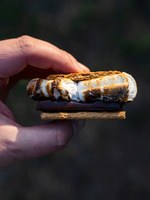CMC Press is thrilled to announce Wild Eats, a new cookbook for outdoor adventuring. This no-fuss, resourceful guide offers 60+ recipes for backpacking and car camping, from breakfast to dessert. Wild Eats also includes instructive how-tos, such as how to dehydrate your own ingredients, how to cook with a Dutch oven, and many more techniques to help you get the most out of cooking outdoors.
Enjoy a sample “how-to” chapter below!
*******************************************************************************************
From Wild Eats: Campsite Cooking
By Nick Cote
HOW TO MAKE THE PERFECT S’MORES
You don’t need a cookbook to tell you how to make s’mores. Of course there are variations, such as using a peanut butter cup instead of chocolate or placing your chocolate-topped graham cracker on a rock next to the fire to slightly melt it first. But let’s be honest—the real challenge is the marshmallow. We’re all guilty of shoving a marshmallow directly into the flame, setting it on fire, then trying to blow it out (or even more egregious, waving it around and flinging a flaming projectile toward fellow campers). Or, if you didn’t wave it around and send it flying or watch it drip off your stick and back into the fire, you likely scraped the crispy, blackened marshmallow onto a graham cracker and just called it good. Because even a bad s’more is still good. But I’m here to tell you, there’s a better way. For the perfect marshmallow, there are two forces at work that you need to understand: first, what type of heat works best, and second, how that heat affects the sugar molecules that you’re trying to keep from burning to a crisp.
Much like grilling with charcoal, glowing embers (not flames) are ideal for roasting marshmallows. Flames are hotter and more volatile than embers, which emit a gentler, more predictable heat that allows you to monitor your mallow’s progress without instantly turning it to ash. This means letting the fire burn down a bit and roasting your marshmallow closer to the embers at the base of the fire rather than directly in the flame.
As for attaining that perfect golden-brown color, the process is called caramelization. Sugar itself is a single type of molecule, but when heat is applied to it, it breaks down into different molecules and creates hundreds of complex new flavor compounds, ranging from nutty and aromatic to bitter and astringent. The more heat that is applied, the less those precious sugar molecules remain and instead are replaced by more bitter compounds, which is why a pitch black marshmallow is probably better off melting into the fire. The sweet spot, literally and figuratively, is somewhere in the middle, where you retain some sweetness and new flavor compounds, but without the bitterness.
So, no, you don’t need a recipe to tell you how to make a s’more, but rather just a reminder to be patient, keep your marshmallow out of the flames, and let science do the work until you’ve achieved golden-brown, caramelized s’more perfection.
***
If you'd like to learn more about how to level up your camp cooking, you can pre-order Wild Eats here.
 CMC Press
CMC Press

Add a comment
Log in to add comments.